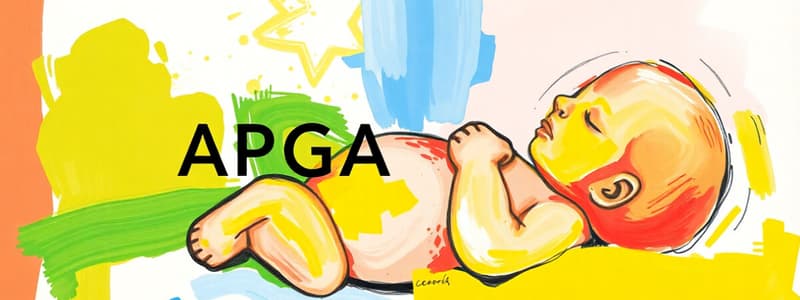Podcast
Questions and Answers
What is the purpose of the Apgar score?
What is the purpose of the Apgar score?
- To determine the age of the newborn
- To evaluate the effectiveness of surgeries on infants
- To calculate the weight of the newborn
- To assess the health of newborns immediately after birth (correct)
Which of the following correctly identifies the scoring range of the Apgar score?
Which of the following correctly identifies the scoring range of the Apgar score?
- 0 to 5
- 0 to 10 (correct)
- 0 to 8
- 0 to 12
What is the acronym used to remember the five criteria of the Apgar score?
What is the acronym used to remember the five criteria of the Apgar score?
- HEART
- CRISP
- PAGER
- APGAR (correct)
Who developed the Apgar score and in what year?
Who developed the Apgar score and in what year?
What is the score for skin color when a newborn has a blue or pale appearance all over?
What is the score for skin color when a newborn has a blue or pale appearance all over?
Flashcards
Neonatal Period
Neonatal Period
The period from birth to 4 weeks (28 days) after birth.
Neonate
Neonate
A newborn infant.
Apgar Score
Apgar Score
A method to assess a newborn's health immediately after birth.
Apgar Score Creator
Apgar Score Creator
Signup and view all the flashcards
Apgar Score Criteria
Apgar Score Criteria
Signup and view all the flashcards
Apgar Score Component: Appearance
Apgar Score Component: Appearance
Signup and view all the flashcards
Apgar Score Component: Pulse
Apgar Score Component: Pulse
Signup and view all the flashcards
Apgar Score Component: Grimace
Apgar Score Component: Grimace
Signup and view all the flashcards
Apgar Score Component: Activity
Apgar Score Component: Activity
Signup and view all the flashcards
Apgar Score Component: Respiration
Apgar Score Component: Respiration
Signup and view all the flashcards
Study Notes
Newborn Period/Neonatal Stage
- Newborn period/neonatal stage lasts from birth to 4 weeks (28 days).
- Neonate is another term for newborn infant.
Apgar Score
- Developed in 1952 by Dr. Virginia Apgar.
- A simple, repeatable method for quickly assessing newborn health immediately after birth.
- Developed to determine the effects of obstetric anesthesia on babies.
Criteria for Apgar Score
- Assesses newborns based on five simple criteria.
- Each criterion is scored from 0 to 2.
- The five criteria are Appearance, Pulse, Grimace, Activity, and Respiration.
- Summing the five scores gives a result ranging from 0 to 10.
Apgar Score Interpretation
- Scores of 3 and below indicate a critically low medical condition requiring immediate attention and resuscitation.
- Scores of 4 to 6 indicate needing low-level suctioning and oxygenation.
- Scores of 7 to 10 indicate normal or good health, needing only basic admission care.
- The Apgar score is taken initially at 1 and 5 minutes after birth; further assessments can happen as needed if scores remain low.
New Ballard Score - Maturational Assessment
- A set of procedures developed by Dr. Jeanne L. Ballard to determine a newborn's gestational age.
- Uses neuromuscular and physical assessments of the newborn fetus.
- Physical characteristics are crucial in determining gestational age.
Anthropometric Measurements
- Weight: Average weight is between 2750g and 4000g (6-9 lbs) at term.
- Under 2750g (5 1/2 lb) is considered small for gestational age (SGA).
- Over 4100g (9 lb) is considered large for gestational age (LGA).
- Usual initial loss of 5%-10% of body weight is normal during the first few days and should be regained in 1-2 weeks.
- Length: Average length is between 46 and 55.9 cm (18-22 inches).
- Under 45.7 cm (18 in) is considered SGA.
- Over 55 cm (22 in) is considered LGA.
- Head Circumference: Average is 33-35.5 cm (13-14 inches), generally slightly larger than chest size.
- Significant molding or caput succedaneum may require re-measurement.
- Under 31.7 cm (12 in) may indicate microcephaly/SGA or hydrocephaly/LGA (over 36.8 cm or 14 in).
- Chest Circumference: Average is 30-33 cm (12-13 inches) or 1.9 cm (3/4 in) less than head circumference.
Newborn Screening
- Screening for various health conditions.
Newborn Head Characteristics
- Disproportionately larger than the body, with a 1/4 larger size.
- In adults, the head is 1/8 the body size.
- Common features include fontanelles, sutures, molding, caput succedaneum, cephalhematoma, and craniotabs.
Fontanels
- Spaces between the bones of the skull.
- Generally flat and open; enlarged or bulging fontanelles indicate increased intracranial pressure.
- Sunken fontanelles suggest dehydration.
- Two types: anterior and posterior fontanels.
- Anterior: diamond-shaped, closes in 12-18 months.
- Posterior: triangular-shaped, closes in 2-3 months.
Sutures
- Separating lines of the skull bones.
- May temporarily override at birth due to pressure during delivery; this is normal.
Molding (Dunce Cap)
- Overlapping of skull bones caused by pressure during labor and delivery.
- The part of the infant's head (vertex) engaging the cervix, gets molded.
- Appears prominent at birth; head may be asymmetrical and is common in first-time mothers.
Caput Succedaneum
- Swelling of the soft tissues surrounding the baby's scalp.
- Continuous pressure applied from the cervix during delivery.
- Edema (swelling) typically resolves within 3 to 4 days without intervention.
Cephalhematoma
- Collection of blood beneath the periosteum of the skull bones.
- Caused by pressure during birth, resulting in rupture of periosteum capillary.
- Usually appears 24 hours after birth, discoloration (black, blue, or red).
- Absorbs and disappears within weeks, but is not harmful.
Craniotabs
- Localized softening of cranial bones.
- Pressure of the fetal skull against the pelvic bones.
- Usually corrected within a few months.
Newborn Eyes
- Newborns cry without tears due to immature lacrimal ducts.
- These ducts mature around 3 months.
- Initial eye color can be gray or blue.
- Sclera (whites of the eyes) are typically blue and thin.
- Permanent eye coloring develops in 3-12 months.
- Assess for any signs that require intervention, such as eye infections or abnormal eye movements.
Newborn Ears
- Ears are not fully developed, and the ear pinna may be flexible..
- The top of the external ear should be aligned with the inner corner of the eyes.
Newborn Nose
- Proportionately larger compared to the face.
- Generally flat, but flaring may indicate airway obstruction due to mucus.
- Assess for choanal atresia (blockage of the nasal passages).
Newborn Mouth
- The mouth usually opens symmetrically during crying.
- Epstein pearls (small, white, round cysts on the palate) are a common finding that often resolve on their own.
- Epithelial pearls are benign cysts present on the gum margin.
- Loose natal teeth (present at birth) should be extracted.
Growth and Development of Infant
- Weight doubles by 4-6 months; triples by 1 year.
- Approximately 1 lb gain per month during 4-6 months.
- Average weight by 1 year (F) :9.5 kg; (M) ~10 kg
- Height increases by 50% by 1 year.
Newborn Body Systems
- Heart rate (HR): 100-120 beats per minute.
- Blood pressure (BP): 100/60 mmHg.
- Hemoglobin (Hg): Physiologic anemia often observed for 2-3 months but decreases afterward.
- Respiratory rate (RR): 20-30 breaths per minute; more prone to respiratory infections immediately after birth. This is due to less efficient mucus production, as well as anatomical characteristics.
- Gastrointestinal (GI) Tract: Deficiencies in enzymes like amylase and lipase, affecting carbohydrate processing and fat digestion. Swallowing may not be fully coordinated immediately after birth. The extrusion reflex is prominent until 3-4 months.
- Liver: Immature liver function, especially in drug metabolism.
- Immune system: Functional adaptive immunity develops after the first year, but innate immunity is already present soon after birth.
Newborn Neck
- Neck is typically short and chubby with visible creases/folds in the skin.
- Congenital torticollis (stiff neck) can be present due to muscle injury from birth.
Newborn Chest
- Chest size is smaller than the head initially.
- Breast engorgement(temporary swelling of the breasts) is hormonal and resolves in a week in both genders.
- Whitish discharge (witch's milk) is normal from the breasts, typically subsiding without intervention.
- Respiratory rate (RR): 30-60 breaths per minute.
Newborn Abdomen
- Typical abdomen is rounded and protruding.
- Possible conditions like a missing abdominal content (scaphoid or sunken abdomen) or diaphragmatic hernia (protrusion of abdominal organs).
- Assess for bowel sounds after an hour in life.
- Wharton's jelly is a transparent gelatinous substance located within the umbilical cord. Its purpose includes protection and insulation of the umbilical cord in the uterus.
- The umbilical cord clamp changes over time, from dry and brown during the first day to black on the 2nd and 3rd day, and typically falls off in 6-10 days.
Anal and Genital Area
- Inspect for anus presence, patency, absence of membrane.
- Assess for meconium (first stool), which should appear in the first 24 hours, to rule out imperforate anus or meconium ileus.
Male Genitalia
- Scrotum is often edematous (swollen) and has folds/wrinkles.
- Two testes typically descend into the scrotum.
- Assess for the presence of the cremasteric reflex (movement of the testicle when stroking the inner thigh) and size (roughly 2cm long).
Epispadias and Hypospadias
- Epispadias: Urethral opening located on the ventral surface.
- Hypospadias: Urethral opening located on the dorsal surface.
Newborn Skin
- Vernix caseosa: A whitish, cheese-like substance found coating the skin. Contains nutrients to protect and provide appropriate thermal regulation.
- Lanugo: Fine, downy hair present.
- Acrocyanosis: Bluish discoloration of the extremities, typically temporary.
- Cutis marmorata: Mottled, normal skin discoloration due to cold exposure.
- Milia: Tiny white bumps on the face caused by blocked sebaceous glands.
Harlequin Color Change
- Pink hue on one side of the body.
Jaundice
- Yellowing of skin/eyes; caused by bilirubin.
- Physiologic jaundice is normal in the 2nd-3rd week of life (needs monitoring; phototherapy may be used).
- Pathologic jaundice occurs within 24 hours and usually indicates a condition requiring more thorough evaluation (RH incompatibility is a possibility).
Birthmarks
- Various types of birthmarks (e.g., Mongolian spots, stork bites, port wine stains, strawberry hemangiomas).
Cryptorchidism
- Undescended testes in males (one or both).
- Possible causes for undescended testes include agenesis (absence of organ development), ectopic testes (located in abnormal positions), or a short vas deferens (the tube that carries sperm).
Immune System
- Functional at 2 months, with IgG and IgM production post-year.
- Ability to regulate temperature, and use shivering and brown fat to manage body temperature.
- Kidneys and endocrine system are immature, with more intracellular fluid.
Teeth
- First tooth erupts around 6 months, with new teeth erupting monthly.
- Natal teeth are teeth present at birth.
- Neonatal teeth (those erupting in first few weeks) are mandibulary central incisor
Studying That Suits You
Use AI to generate personalized quizzes and flashcards to suit your learning preferences.




